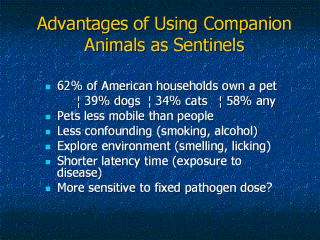| front |1 |2 |3 |4 |5 |6 |7 |8 |9 |10 |11 |12 |13 |14 |15 |16 |17 |18 |19 |20 |21 |22 |23 |24 |25 |26 |27 |28 |29 |30 |31 |32 |33 |review |
 |
· Greater than 40%
of all households in the U.S. have one or more cats or dogs and many of
these animals eat human foods and sleep in bed with their owners. These
animals provide a good window into the health of the human environment in
which they live. · Studies have shown that companion animals develop disease as a result of chronic exposure to environmental chemicals such as cancers caused by asbestos (mesothelioma) and herbicides applied to lawns (bladder cancer). · The latency period for these cancers is significantly shorter for animals than it is for humans. For example, the latency period for mesothelioma in humans and dogs is 30-40 years versus 8-10 years, respectively. In contrast the latency period for acute toxicity caused by lead and herbicides is measured in hours or days and is similar in animals and humans. · Dogs and cats may be more sensitive to a fixed pathogen dose due to their higher respiratory and metabolic rate than humans. |